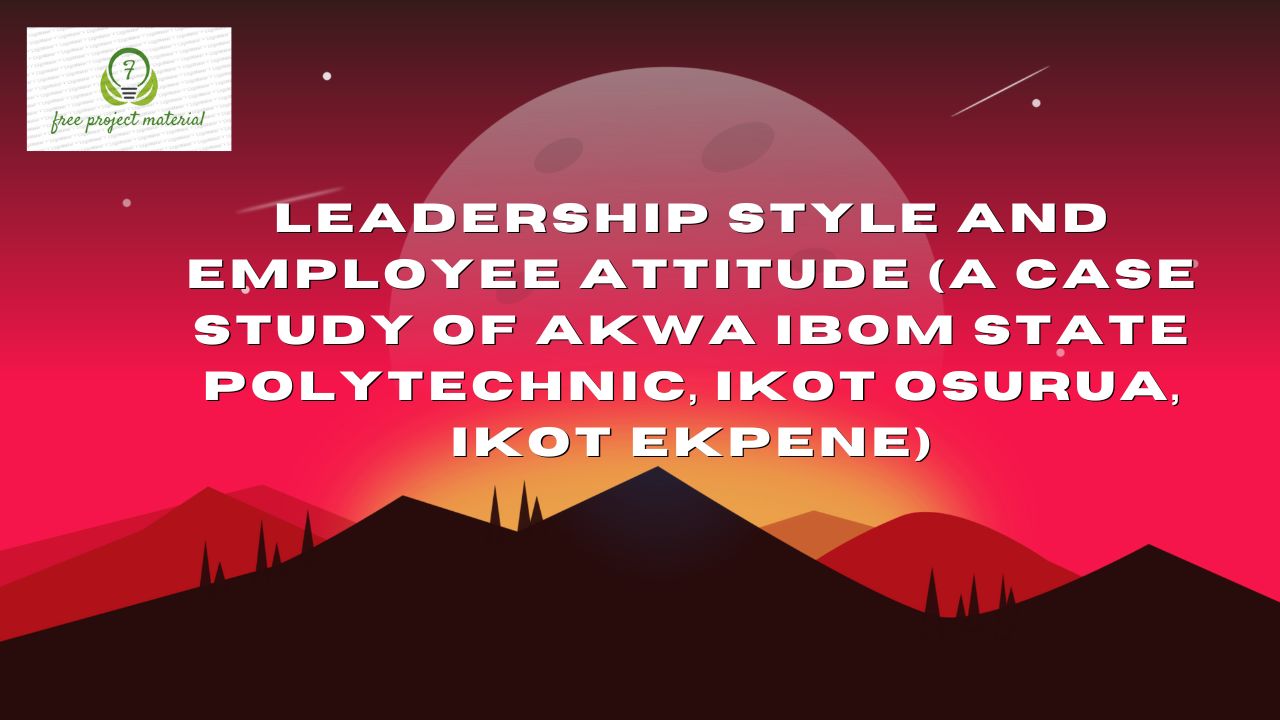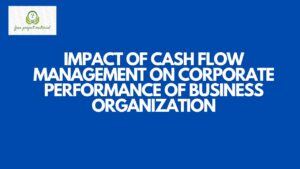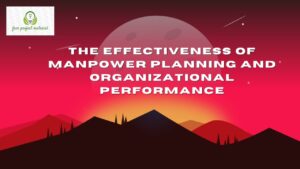ABSTRACT
The aim of this study was to examine leadership style and employee’s attitudes using Akwa Ibom State Polytechnic, Ikot Osurua as a case study. To achieve the objectives of this study, the study made used of survey research design. Taro Yamane formular was used to determine the sample size of 251 from the population of 676 for the study while convenience sampling technique was used to select the respondents. Data collection for the study was a self-developed questionnaire which was personally administered. Data were analyzed using simple percentages and frequency tables. Based on the findings of the study the data analysis revealed that Democratic, Lasseze-faire and Beaurocratic leadership styles have significant effect on employee’s attitude while autocratic leadership style does not since, all decisions are taken by the leader only and the contribution of the employees are not required. It is recommended that to be an effective leader, there is need to adopt a multiple approach rather than a singular style when dealing with employees in an organization. It is also recommended effective communication as a guide to every leader.
LIST OF TABLES
Table 4.1.1 Responses to Research Question (1)……. 55
Table 4. 1.2 Responses to Research Question (2). …. 56
Table 4.1.3 Response to Research Question (3)…….. 57
Table 4. 1.4 Responses to Research Question (4)……. 58
TABLE OF CONTENTS
Title page – – – – – – – – – i
Approved page – – – – – – – – ii
Certification – – – – – – – – iii
Dedication – – – – – – – – – iv
Acknowledgement – – – – – – – v
Abstract – – – – – – – – – vi
List of Tables – – – – – – – – vii
Table of Contents – – – – – – – – viii-xi
CHAPTER ONE
INTRODUCTION
1.1 Background of the Study – – – – – –
1.2 Statement of the Problem – – – – – –
1.3 Objective of the study – – – – – –
1.4 Research Question – – – – – – –
1.5 Significance of the Study – – – – – –
1.6 Scope of the Study – – – – – – –
1.7 Limitations of the Study – – – – – –
1.8 Organization of the Study – – – – – –
1.9 Definition of Terms – – – – – – –
CHAPTER TWO
REVIEW OF RELATED LITERATURE
2.1 Conceptual Framework – – – – – –
2.1.1 Marketing Research – – – – – – –
2.1.2 Customer Intensity – – – – – –
2.1.3 Unpackging the Concept of Market Orientation – –
2.1.4 Value Creation – – – – – – –
2.1.5 The Role of SMEs in Nigeria Economy – – –
2.1.6 Importance of Marketing Function of SMEs – –
2.1.7 History of Small Business Survival and Demise – –
2.1.8 Small Business and Business Strategies – – –
2.1.9 Regulatory Environment of SMEs Marketing in Nigeria –
2.1.10 Internal Determinant of Firm’s Survival
2.1.11 Customers as Survival Instrument for Small Scale Enterprise
2.1.12 Supplier as Survival Instrument for Small Scale Enterprise
2.1.13 Economy as a Survival Instrument for Small Scale Business
2.1.14 Industry/Technology as Survival Instrument for Small Scale Enterprise
2.2 Theoretical Framework – – – – – –
2.2.1 Lazaer’s Theory Entrepreneurship – – – –
2.2.2 Marketing Practice Model – – – – –
2.3 Empirical Framework – – – – – –
2.3.1 Business Survival in the Light of Lazear’s Theory
2.3.2 Impact of marketing practices on the performance of small business enterprise
CHAPTER THREE
RESEARCH DESIGN/ METHODOLOGY
3.1 Research Design – – – – – – –
3.2 Population of the Study – – – – – –
3.3 Sampling Size – – – – – – –
3.4 Instrumentation – – – – – – –
3.6 Method of Date Analysis – – – – – –
3.7 Problems of Data Collection – – – – – –
CHAPTER FOUR
DATA PRESENTATION ANALYSIS AND INTERPRETATION
4.1 Analysis of Research Questions – – – – –
4.1.1 Analysis of Research Question One – – – –
4.1.2 Analysis of Research Question Two – – – –
4.1.3 Analysis of Research Question Three – – –
4.1.4 Analysis of Research Question Four – – – –
4.2 Discussion of Findings – – – – – –
CHAPTER FIVE
SUMMARY, CONCLUSION AND RECOMMENDATION
5.1 Summary of Findings – – – – – –
5.2 Conclusion – – – – – – – –
5.3 Recommendations – – – – – – –
References
Appendix I
Appendix II
CHAPTER ONE
INTRODUCTION
1.1 Background of The Study
Leadership is an area of managerial responsibility that is needed to develop plans, set objectives that help the organization cope with the future and to meet the demands of the environment. The technical, economic, social and political characteristics of organization brings about continuing need for the innovation, creativity and imagination of a leader. Leadership ability therefore is a valuable skill and those who possess or have it reap high rewards. The universal dearth of effective leaders causes organization to scout constantly for them and fosters development and better utilization of existing leadership.
Leadership is the ability of an individual to influence others to work beyond ordinary level to achieve a goal or an objective. Leadership is generally defined as influence, the art or process of influencing people so that they will strive willingly towards the achievement of group goals. To lead is to guide conduct and direct. Leaders act to help a group achieve objectives with maximum application of its capabilities. They do not stand behind a group to prod; they place themselves before the group as to facilitate progress and inspire the group to accomplish organizational goals.
A pertinent example is that of the orchestra leader, whose function is to produce coordinated sound and correct tempo through integrated effort of the instrumentalist.
Leadership has an effect on the performance of any organization. It affects both the employees attitude and productivity of the organization.
Employees at all levels tend to evaluate the jobs and their organizations according to the kind of leadership behaviour their bosses exhibit, for a leader to lead effectively and efficiently he needs to understand his followers and the situation in the organization. The situational variably which influences the effectiveness of a followers and the task organizational climate power available to the leader and leader – follower relationship.
Basically, people tend to follow those they see as a means of satisfying their needs. The task of a leader is to encourage people to contribute effectively and willingly towards the accomplishment of enterprise goal, and to satisfy their own needs in the process.
The leader must always be aware of the human problems a as sensitivity towards the hopes and aspirations of those whom he supervised and a capacity for analysis of emotional forces that motivate their conduct, if this is not achieved the projects entrusted to him will not work out, no matter how often wages are raised.
The survival of every organization depends on the performance of its leader. He moves the group within the constraints of its maximum compatibilities to attain certain specified objectives. He handles people, motivate them to work with them to do. In order not to lose his identity he takes his place before the group as he inspires the group to accomplish organizational objective.
In fact he is an architect of the performance, and hence tries to increase the moral of his employees always. Research findings however suggests that leadership effectiveness is not depended on the source of power alone but with situational factors, climate or any particular style.
1.2 Statement of the Problem
One of the most researches and lest understood variables of the management process is leadership.
For centuries scholars have been speculating on the nature of leadership to adopt. Only in the recent years have researchers conducted systematic investigations that have yielded useful insights into dimensions of leading. Even with this, there is still an increasing difficulties to establish the fact that leaders achieve the desired result as and when is need.
The prosperity, if not the survival of any organization depends on the performance of its leader and their styles. The quality of leadership style shapes the behaviour of their employees at all levels tend to evaluate their job and their organization according to the kind of leadership behaviour their bosses exhibit. Theoretically, in appropriate usage of some style result to workers negative attitude to work, absenteeism, conflict, unrest and confrontation. All these are rampant in most of the organization today.
This research work aims at evaluating the type of leadership in existence and why they vary in their method of operation. The work also intends to find out whether leaders recognize their position in the organizational set of and if they do, to what extent do they exercise their leadership power and style to exhibit positive attitude from the employees for an increased productivity. Some leadership styles in themselves are retrogressive and generate ill-feelings among employees. Most leaders always think that all employees should be treated the same but each individual background, orientation education largely determine the best of leadership with which they could be led.
On the whole the research will critically assess the reaction of employees to the styles used by their leaders.
1.3 Objectives of the Study
The main objective of the study is to examine leadership style and employee’s attitude
The following are the specific objectives of the study:
- To determine the impact of democratic leadership style on employee’s attitude
- To examine the impact of autocratic leadership style on employee’s attitude
- To examine the effect of Laisseze-faire leadership style on employee’s attitude
- To examine the influence of Beaurocratic leadership style on the employee’s attitudes.
1.4 Research Questions
- What is the impact of democratic leadership style on employee’s attitude?
- What is the impact of autocratic leadership style on employee’s attitudes?
- What is the effect of Laissez-faire leadership style on employee’s attitudes?
- What is the impact of Beaurocratic leadership style on the employee’s attitude?
1.5 Significance of Study
The existence of a good leadership style in any organization is crucial and will ultimately affect every body either directly or indirectly. This study will be of greater significance to the management team of Akwa Ibom State Polytechnic team in particular.
The research study also helps to enlighten the management of organization on the need and importance of having effective leaders in the organization. Similarly, the study enlightens employees on their roles and obligations to the leadership in the organization and other related matters. This study identified the reason why employees react positively to a particular leadership style of a manager and also aim at discovering what makes workers to be dedicated and committed to their duties
This research work will also be helpful to future researchers as reference purpose or academics literature and in particular to students of management as well.
1.6 Scope of the Study
This study centers on leadership style and employee’s attitude using Akwa Ibom State Polytechnic as a case study.
1.7 Limitations of the Study
The research encountered some constraints which limit the scope of this study such as
Unavailability of research materials: the research material available to the research is insufficient.
Time: The time strain did not allow wider coverage. This was occasioned by the researcher having to combine the research and other academic activities.
Financial Constraint: Insufficient funds impinged on the extensive sourcing of materials, literature information and in the process of data collection via internet, questionnaire and interview.
1.8 Organization of the Study
The study is divided into five chapters. Chapter one discusses a general introduction and an overview of the background to the research, statement of problem, research objectives, research questions, significance of the study scope of the study, limitation of the study, and the structure of the research. Chapter two looks at the literature review of the research, the conceptual framework, theoretical framework and empirical framework of the research.
Chapter three focuses on the research methodology in terms of research. Design, population of the study, sampling technique, sample size, instrumentation, method of data Analysis and problems of data collection.
Chapter four focuses on Data presentations, Analysis and interpretation.
Chapter five carries the summary conclusion and recommendation.
1.9 Definition of Terms
In order to facilitate effective understanding of the content of this study, the following important terms have been defined.
Leadership: The art or process of influencing people so that they will strive willing toward achievement of group goals.
Evaluation: This is a method of appraising the value of a particular thing in the course of study. It is a situation where the authenticity of study is examined and logical conclusion drawn.
Objective: This refers to the end – target set to be achieved by the organization in the course of operation
Style: These are various approaches leaders adopt in dealing with subordinates for accomplishing the set objectives of the organization.
Organization: This means a purposeful social unit. It is defined establishment or corporate entity public, private or services or produce goods and set-up to render services or produce goods and to carry out more precisely policies and programmes inspired.
Influence: This is the power to effect subordinates characters, beliefs or action through example, fear or admiration with or without forces.
Power: This refers to one who applies sanctions that requires or prohibits the commission of an act.
Employees: Employees is a general term referring to one who work for wage and salary and perform services for an employer.
Attitude: Attitude is referred to as manner of placing or holding the body and way of feeling, thinking or behaving
Leadership style: refers to the pattern of behaviours that leaders display during their work with and through others.



